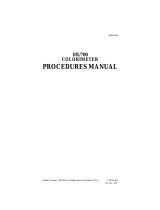
8. Procedure
• Open two sealed cassette. It is recommended to perform steps A and B for each sample
evaluation.
A.
Sample:
NOTE: Each sample dilution buffer tube contains 20ul of a buffering solution necessary for proper running of
the strip. Perform a quick centrifugation of the sample dilution buffer tube to ensure the buffer solution
is at the bottom of the tube and not stuck on the sides or top.
o Using the pipet transfer 200ul of sample into to one of the sample dilution buffer
tubes.
o Mix the sample with the sample buffering solution by pipetting up and down 3 times.
o Using a pipet add the buffered sample directly into the sample port of the cassette.
B.
Negative Control:
o Pipet 200ul of the solution in the Negative Control tube directly into the sample port
of the cassette.
C.
Immediately following steps, A and B
o Set a timer for 10 minutes.
o Read results using your eye or with a lateral flow reader. For additional details see
section 9 on interpretation of results.
9. Interpretation of Results
This test is a competitive lateral flow assay containing a control line dependent on the amount of
microcystin is in the sample.
What to expect at the test line: The higher the concentration of microcystin is in the sample the lower
the intensity of the test line compared to the negative control.
What to expect at the control line: The intensity of the control generally will increase as the test line
decreases.
For samples prepared as described above, screening concentrations are determined by comparison
of the intensity of the test line on parallel test strips. Test strips with a test line which is darker than
or of equal intensity to the test line of the control indicates a result which is the sample is negative
or below the limit of detection of the test. Test strips with a test line which is lighter than the control
strip indicates a result which is ≥ 4 ppb. Test strips with no test line visible (only the control line is














